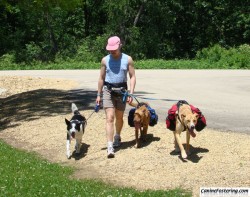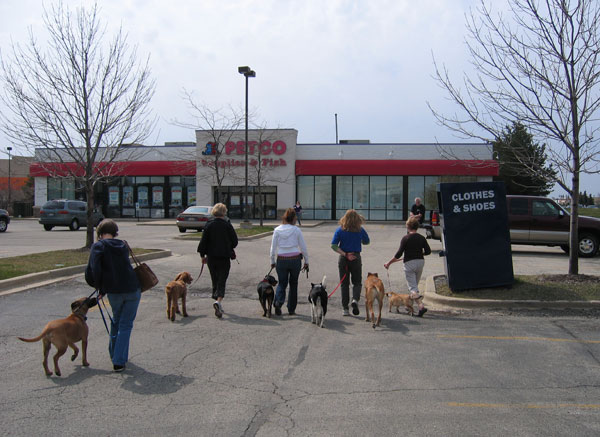An insight on hiking with your dogs
While we were camping recently I had an insight – the “rules” for walking correctly don’t always apply. For instance, we were hiking and two of my dogs wear backpacks. They carry all the water for the group (for us and for them) and carry our lunch. They have a heavy load on their backs and need a bit of room to sway from side to side. It is frustrating and difficult to keep them close, like I usually do, because the packs keep banging into my legs, knocking both of us off balance. I tried for a spell, to keep them behind me but that was also unpleasant as they tended to drip their saliva down the backs of my legs (which is as gross as it sounds.) The solution? I hooked the leash onto the clip on the back pack (we use wonderful packs from RuffWear) and let them walk in front of me. In my opinion this is the perfect solution. They get to have all the room then need to do their “work” and I am free to walk unencumbered.
 As you see, they are both working so hard they are staying pretty close by. It was a great solution to this problem. In addition, you’ll see my dog, Bella, on one of those extension leashes. Ordinarily I HATE those leashes as they are used in city walking and the dogs are usually out in front, extending the leashes to their maximum length. This is just a recipe for a whole host of problems, in my opinion. But on a hike, these leashes provide the dog with more room to explore while still being under your control. After a good long hike, you can see, they don’t really want to go that far in front anyway and if they are primarily walked close at hand, that’s where they’ll end up. So, with all things dog training, remember that rules usually need to be broken from time to time.
As you see, they are both working so hard they are staying pretty close by. It was a great solution to this problem. In addition, you’ll see my dog, Bella, on one of those extension leashes. Ordinarily I HATE those leashes as they are used in city walking and the dogs are usually out in front, extending the leashes to their maximum length. This is just a recipe for a whole host of problems, in my opinion. But on a hike, these leashes provide the dog with more room to explore while still being under your control. After a good long hike, you can see, they don’t really want to go that far in front anyway and if they are primarily walked close at hand, that’s where they’ll end up. So, with all things dog training, remember that rules usually need to be broken from time to time.
The important thing is to always ask yourself this question: Who is the leader here, and who is the follower?
Creating a good dog walking experience
Ahh, nothing better than walking a dog on a lovely spring day. How about we all go together? What? Can’t? The dog “doesn’t like other dogs? People either? The dog’s leashes will get all tangled up and cause a minor disaster? eh, too much work, you’re right, let’s just skip it and let them out back.
So SAD! There is a sense of peacefulness that comes from walking with a group of dogs that can’t be matched. Dogs are pack animals, meaning they like to be with other dogs. Some of them just don’t know that or have forgotten. We are sort of pack animals too, we like to be together. So getting your dog to have nice leash manners is a skill that helps you both fulfill this urge to be together with your own kind in a productive, peaceful way.
Ok, so what are “nice” leash manners? Nice means: no pulling, no tripping me up, no tripping anyone else up, no growling or snapping at other beings, no incessant stopping to sniff every little thing, no lunging after the neighbor’s cat or the neighborhood rabbit or squirrel or deer or elephant (I don’t know where you live), no barking at anything, and generally enjoying being together.
Placement has a lot to do with fostering “nice” manners. A dog in front is a dog in charge and if that dog has anything other than a laid back, pacifist sort of personality they shouldn’t be in charge. Most dogs, nearly every single dog I’ve ever seen are much happier with you in charge of the walk. Really, much HAPPIER. Don’t confuse excitement – that frantic panting jumping barking energy for happiness. A happy dog is a calm dog that looks content. A hyper dog isn’t happy, he’s crazy. We don’t want crazy people leading us nor do we want crazy dogs leading us.
So, keep your dog at your side. Draw an invisible line from your knees out to either side of you and that is the line the dog should stay behind at all times. Walking like this gives a dog a job, a sense of purpose. Try it yourself…when you’re out walking with a friend try to keep yourself behind their invisible line. It takes mindfulness of what you are doing and that is what we are after with out dogs. It is a mental. challenge.
Now, doing this can be difficult. A dog who is used to leading isn’t going to give up that position instantly. Mostly because they have been conditioned to walk there – it is what they know. You have to show them a new way. If you’re consistent, soon that will be what they know. To keep them at your side you have to shorten the length of leash between you and your dog. For that reason, I always suggest using a simple nylon, one ply, 1/2 inch leash no longer than 4 feet. And I suggest tying a knot in the leash where your hand should fall. That way you always know if you’re holding the leash in the right spot. People who train with me always get their leashes tied. It’s just my thing.





